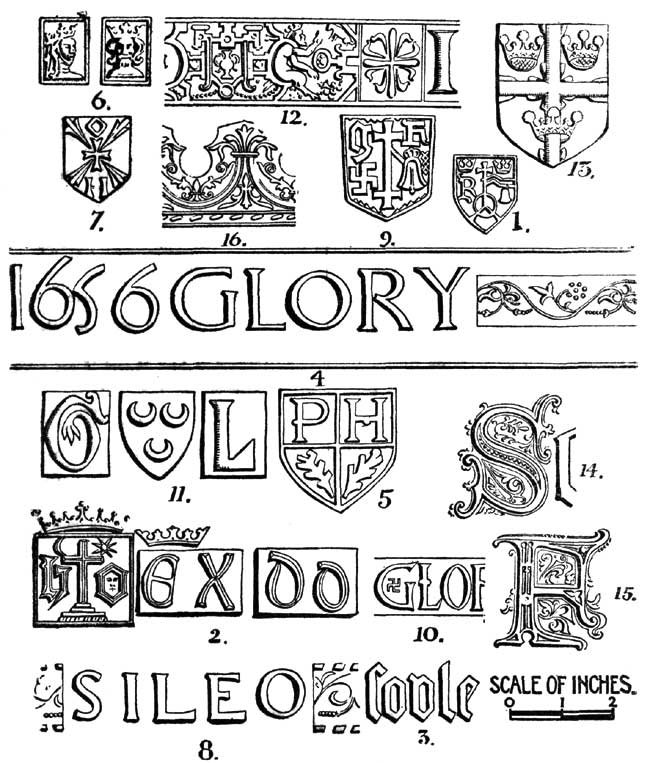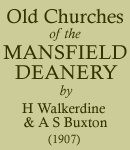< Previous | Contents | Next >
The Bell Founders
THE bells, with the associations clustered around them, form by no means the least interesting feature of our churches. Formerly the bells entered far more deeply into the life of the people than they do to-day, and the English have always been considered a bell-ringing nation On this particular score a foreigner writing at the end of the 16th century says: "The English . . . are vastly fond of great noises that fill the ear, such as the firing of cannon, beating of drums, and the ringing of bells," then he proceeds to give an account of what he saw in England, thus: "It is common for a number of them that have got a glass in their heads to get up into some belfry and ring the bells for hours together for the sake of exercise." Contrasted with this the people to-day who live near the church have little to complain of when the bell-ringers indulge in a course of Bob Major or Grandsire Triples. But the old people loved their bells, each parish vying with the next to get the best peals, hence much amusing doggerel was written lauding up a particular peal to the disparagement of those of the neighbouring villages such as: "Colston's cracked pancheons, Screveton's egg shells, Bingham's two rollers, Whatton's merry bells." Much fine ornament is hidden away amid the gloom of the belfries, together with curious marks of the bell founders. A short account of the bell makers of the Deanery may therefore be of interest.

Marks and ornament found on bells.
In the belfry at Sutton-in-Ashfield is a bell which has been recast by Taylor and Co., of Loughborough, but which still retains the trade mark of the original maker, Richard Mellors (Fig. 1.) Like many others of the same period this rebus is of obscure meaning and shows the ease with which the mediaeval people were satisfied if the symbols employed could be twisted into a semblance of the name they were intended to mark. The explanation of this mark is that the letter R. stands for Richard, the bell for Mellors, a doubtful pun upon his name and trade, while the crowns were probably introduced from the town arms to signify Nottingham, the whole thus reading: "R. Mellors, bellyetter, Nottingham." Richard Mellors worked in Nottingham as a bell-founder in the latter half of the 15th century and the beginning of the 16th. He was a man of some wealth and standing, and held the office of Mayor for Nottingham in 1506. His wife, Dame Agnes Mellors, founded the Nottingham Free School.
The Oldfield family appear as bellfounders in Nottingham towards the end of Henry VIII.'s reign. At Teversal is a bell, the gift of Roger Greenhalgh. made by the first of this family, Henry Oldfield. This bears his mark and shows one type of his lettering (Fig. 2), while Fig. 3 illustrates his usual style, and is taken from a bell in St. Peter's Church, Mansfield. Henry Oldfield's mark is to be found at Kirkby, Warsop, and Papplewick, and consists of a cross on Calvary between the letters H. and O. with a crescent and star above, the star being taken from the town seal of Nottingham. In addition to this mark—his only one in the Deanery—Henry, in his later years, used another, which is rare, with a bell on a shield enclosed in a circle composed of these words: "+ made bi Henri Ouldfeld I." Such was Henry's fame that when Great Tom of Lincoln needed recasting in 1610-11 he was employed with Robert Newcombe, of Leicester, to do the work. Referring to this the Rev. J. J. Raven, in the "The Bells of England, says: "Some consider this union of founders to be due to the fact that Newcombe lived in the diocese, and that Oldfield had the higher reputation."
George Oldfield was the son of Henry, and, likewise, worked at Nottingham. He used the mark of his father (Fig. 2) substituting G. for H. Another mark of his, rare, and not found in the Deanery, is a fleur de lys between the letters G. and O. The lettering (Fig. 4) is taken from a bell of his at Suttpn-in-Ashfield. At Kirkby is a bell bearing shield (Fig. 7), together with the King and Queen's heads, Fig. 6; according to North denotes the work of the Oldfield's, the King and Queen's heads being a mark which had fallen into their hands amongst the stock of some pre-Reformation bell-founder. The inscription on the Kirkby bell is: "I.H.S. Maria, and North, in his "Bells of Lincolnshire," states in the inscriptions on eleven bells in that county bearing the double marks four commence "Nomine," and seven "I.H.S." The band of ornament (Fig. 12) taken from a bell at Woodhouse shews another style of Oldfield ornament. The same bell bears also the shield (Fig. 13). The shield (Fig. 5) bearing in the top quarters P.H., is taken from one of the Selston bells, which also bears George Oldfield's usual mark. The letters P.H. may possibly represent a Philip Oldfield working in conjunction with his brother.
In the 18th century the Hedderley's were famous bellfounders. They were first in business at Chesterfield, Bawtry, and Derby, afterwards coming to Nottingham. Thomas Hedderley first appears in Nottingham as a successor to the Oldfield's, in 1742. He used the stamp, Fig. 6, already mentioned, of King and Queen's heads. The Hedderley's name frequently occurs in old churchwardens' account in the Midlands with a variety of spelling rendered: Heddeley, Eddearley, and Edderly, whilst Thomas himself spells the name Hedderly on the Woodhouse bell from which the lettering, Fig. 8, is taken.
A family of bellfounders who did much work in the Midlands were the Heathcotes. Towards the latter half of the 15th century Ralph Heathcote set up a foundry at Chesterfield, where he worked until his death in 1502. Ralph had two sons—Ralph and George —who died respectively in 1525 and 1558. The son Ralph had a son George who also carried on the bellfounding business. The peculiar mark, illustrated in Fig. 9, from one of the Woodhouse bells, where it is used in conjunction with the mark I.H.C., belongs to one of the Georges, but as the bell is undated it is impossible to say which. This mark consists of a double cross between G. and H., under the H. is a section of a bell with the clapper exposed, and under the G. a fylfot cross. The sign of a fylfot cross is of extremely ancient origin and is found widely scattered amongst the ornaments of early races. Dr. March says: "It is found on Archaic Greek pottery, on tne stamped clay of Swiss lake dwellings, adorning Latin inscriptions on Roman altars." Also it was used in India, Asia, Scandinavia, Iceland, Shetland, Scotland, Ireland, and England.
According to Dr. March it originally was used to denote the axial rotation of the heavens, but latterly as a benedictory sign or mark of good luck. It is a significant fact that in England its presence on bells is confined to those parts of the country which once formed Danish Mercia, where it would appear to be a tangible reminder of the great Scandinavian invasion. This race used it as a symbol of Thor's hammer, and the Rev. J. J. Raven says: "connected with Thor it was readily connected with the thunder of Thor's chariot, and as the power of bells in quelling thunderstorms was unquestioned it is no matter for surprise that some founders adopted it as a quasi-heraldic 'charge' in their shield-shaped marks." Bells are frequently rung during thunderstorms to quell the evil spirits of the air, and we have seen quoted as one of many this entry from churchwardens' accounts: "Paid for bread and drink for the ringers at night in the thundering." Pig. 10, taken from a bell at Teversal cast in 1617, shows the fylfot cross used as a decoration inside the letter G of the word Gloria.
One of the Papplewick bells was cast by Ed. Arnold, of Leicester. Arnold first worked at St. Neot's with his cousin, Joseph Eayre, where he cast bells for some of the Derbyshire churches. On the death of Eayre, Arnold worked with Thos. Osborn some ten years, they then dissolving partnership, and Arnold going to Leicester.
In the 18th century the name of Lester and Pack, of London, stood high, and Mansfield, has two bells cast by them. Thomas Lester succeeded R. Phelps, and carried on the business until about the middle of the century vyhen he took Thomas Pack into partnership. On the death of Lester, William Chapman was taken into the firm which then became Pack and Chapman. After Pack's death towards the end of the century Chapman took into partnership Mears, another celebrated founder, into whose family the whole business eventually passed. First came William Mears, then W. and T. Mears. Thomas Mears from 1791—1804 stamped his name only on the bells. His son, Thomas cast the whole of the Linby peal in 1826. Prom bells at Warsop (1812) and Skegby (1830) bearing only these dates and the maker's name it appears that bell founding was carried on in a small way at Mansfield by S. Mid worth.
Of the modern bellfounders Taylor and Co., Loughborough, cast bells at Suttqn and Woodhouse, and Barwell, of Birmingham, some at Selston. The Taylor's first carried on the St. Neot's foundry after Arnold, to whom Robert Taylor had been apprenticed. They moved to Oxford, and finally settled at Loughborough.
The mark No. 11 is taken from a bell at St. Peter's Church, Mansfield, where there is also another cast in 1611, bearing a cross fleury between the same initials. In the 17th century a George Lee was casting bells for Lincolnshire churches.
The letters Nos. 14 and 15 are taken from the 1603 bell at Teversal, which unfortunately has no bell mark.
Pig. 16 gives a type of ornament used by various makers in the 17th and 18th centuries, and to be found on many bells in the Deanery. The name of Thomas Wheeldon occurs at Kirkby on a bell cast in 1803.
In the tower of Annesley Church were three old bells, one bearing date of 1634, and two 1682. We cannot give any particulars as to marks as these bells were destroyed in the disastrous fire last January.
